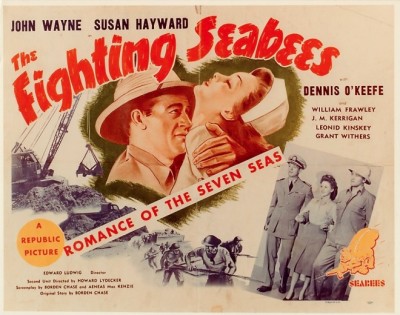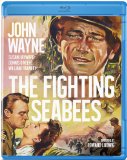| Reviews & Columns |
|
Reviews DVD TV on DVD Blu-ray 4K UHD International DVDs In Theaters Reviews by Studio Video Games Features Collector Series DVDs Easter Egg Database Interviews DVD Talk Radio Feature Articles Columns Anime Talk DVD Savant Horror DVDs The M.O.D. Squad Art House HD Talk Silent DVD
|
DVD Talk Forum |
|
|
| Resources |
|
DVD Price Search Customer Service #'s RCE Info Links |
|
Columns
|
|
|
Fighting Seabees, The
The Fighting Seabees was John Wayne's third war movie (not counting Pittsburgh, in which the war figures only slightly), following the Only Angels Have Wings-inspired Fighting Tigers and Reunion in France, both 1942. Although Wayne would eventually become closely tied to the war movie genre, second in popularity and number only to his Westerns, these and They Were Expendable, which premiered after V-E Day but before V-J Day in May 1945, were the only ones actually released during the war.
Ironically, while in The Fighting Seabees he plays an impatient just-give-me-a-gun-and-let-me-fight man of action, Wayne himself never enlisted. His four children entitled him to a 3-A deferment though he could have enlisted as many other 3-A status fathers and industry peers did. Director-mentor John Ford and others encouraged him to enlist throughout the war, but Wayne kept putting it off until it was too late. Many believe his subsequent super-patriotism politics after the war were a direct result of the guilt he felt for not serving, and it was a topic off-limits in interviews.
Olive Films' Blu-ray of The Fighting Seabeas is variable but mostly excellent. There's a fair amount of speckling and other damage, but the sharp image allows viewers to really appreciate the film's scale during its impressive battle scenes particularly. For years most films in the Republic Pictures library looked terrible on home video. New transfers like these are a revelation.
Soon after Pearl Harbor, respected but hotheaded construction company owner Wedge Donovan (John Wayne) is upset that his men, all civilians, aren't allowed to carry firearms to protect themselves from the Japanese while building airstrips in the Pacific. Greeting his men in the docks of New York, he learns five didn't come back while many others were wounded.
Navy Lt. Commander Robert Yarrow (Dennis O'Keefe, in a role intended for George Reeves until he was drafted) proposes absorbing construction work into a new wing of the U.S. Navy, but Donovan is vehemently against the idea of his men having to first go through a rigid basic training program, and of other Navy procedures he feels would only slow down his construction projects.
Instead he decides to accompany his men on the next job, to build another airstrip on a remote Pacific island. When the Japanese begin bombing and invading the island, Donovan foolishly leads his men into battle using rifles they've secretly stashed in one of their trucks, blundering into a foolproof crossfire trap set by Yarrow. Instead of vanquishing the Japanese with minimal casualties, Donovan's foolhardiness causes many of his own men to be killed or wounded.
Among the critically wounded is Yarrow's girl, war correspondent Constance Chesley (Susan Hayward), who by this time has fallen in love with Donovan instead, this despite his incredible pig-headedness.
The Fighting Seabees presses most of the right buttons, introducing an ensemble of colorful (and predominantly Irish-American) types playing Donovan's construction workers (among them are William Frawley, Paul Fix, J.M. Kerrigan, Grant Withers, Ben Welden, and Duncan Renaldo), only to have them die heroically or needlessly or ironically later in the film. The enemy either is a faceless hoard of invading marauders or ruthless, mostly unseen assassins picking off workers one-by-one. Of the Axis powers, the Japanese were singled out as inhuman monsters in American propaganda, and The Fighting Seabees has its share of whoppers, Yarrow arguing, "We're not fighting men anymore. We're fighting animals," while Donovan calls the enemy "bug-eyed monkeys." (However, more than once Yarrow and Constance refer to Donovan as "a big ape.")
The movie fascinates in the way it admonishes Donovan for stubbornly refusing to get with the program, that his stubborn individuality is directly responsible for many deaths (rarely has such a "hero" been so reckless yet come off so well by the final reel), and insisting the war can only be won if he submits completely to the Navy way of doing things. Constance's near-death experience especially turns the tide and, now humbled, overnight Donovan becomes the ultimate team player insisting every report be filed in triplicate ("I was never one for sitting on the fence," he explains). And yet during the climax only by doing exactly the wrong thing, by exerting his individuality and disobeying orders does he save his battalion.
Similarly, the film's trite romantic triangle exemplifies another component common to such films, that of the female lead whose role isn't so much to stand between two men each fighting for her affections, but rather to create a bond of inseparable friendship between the two opposing men and then selflessly get out of the way for the greater good. Just like real life.
The film was an ideal showcase for Wayne - he even gets to Jitterbug in an early scene - while its large-scale battle scenes still impress. Howard and Theodore Lydecker were Republic's special effects wizards, early geniuses in the art of miniature models. Here, instead of their usual work Republic split them up, with Howard directing a second unit crew that, presumably, would have shot most of the battle footage not featuring Wayne or O'Keefe. Filmed mainly at Iverson Ranch, this footage utilizes almost no miniatures at all but rather consists almost entirely of full-scale destruction effects, including some spectacularly huge explosions.
Video & Audio
In black-and-white and in its original 1.37:1 screen shape, Olive Film's presentation of The Fighting Seabees will be a revelation for those who know the film only from earlier VHS versions or Artisan's 2000 DVD release. The film is, as they say, "unrestored," meaning that it has a lot of speckling, inconsistent PQ during dissolves and fades, and some chemical damage here and there but overall it's bright, very sharp and a major upgrade. The Region A disc has decent audio, English only with no subtitle options, and No Extra Features.
Parting Thoughts
Full of wartime clich�s but undeniably exciting and entertaining, The Fighting Seabees is Highly Recommended.
Stuart Galbraith IV is a Kyoto-based film historian whose work includes film history books, DVD and Blu-ray audio commentaries and special features. Visit Stuart's Cine Blogarama here.
|
| Popular Reviews |
| Sponsored Links |
|
|
| Sponsored Links |
|
|
| Release List | Reviews | Shop | Newsletter | Forum | DVD Giveaways | Blu-Ray | Advertise |
|
Copyright 2024 DVDTalk.com All Rights Reserved. Legal Info, Privacy Policy, Terms of Use,
Manage Preferences,
Your Privacy Choices | |||||||














